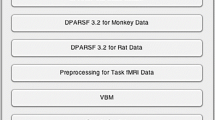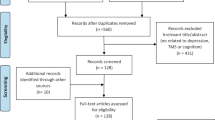Abstract
Variations in frontal lobe (FL) functional anatomy, especially the subgenual cingulate gyrus (SGC) suggest that mapping on an individual rather than group level may give greater insight regarding dysregulation of the neural circuitry involved in depression, as well as potentially provide more specific or individualized treatment plans for depressed patients. We designed a functional MRI task capable of imaging FL activity in individuals, including the SGC region, using a transient sadness paradigm. We sought to develop a method that may better detect individual differences of FL subregions related to sadness, since this region has been implicated to show dysregulation in depression. The task was based on a block design that also accommodates individual differences in responsivity to a sadness induction paradigm. Individual differences from nine non-depressed healthy volunteers were analyzed. We also performed functional connectivity analyses to further characterize our findings to the networks associated with the SGC in each individual. The study was designed to account for individual variation rather than using a true experimental design; therefore, no control group was necessary. As expected, due to inter-individual variability, the specific site of SGC activation during sadness varied across individuals. Activation was also observed in other brain regions consistent with other studies of induced sadness and depression. Patterns of functional connectivity to the SGC also highlighted neural circuits known to subserve sadness and depression. This task promises to more precisely localize a given individual’s functional organization of the brain circuitry underlying sadness, and potentially depression, in an efficient, standardized way. This task could potentially aid in providing individualized targets in the treatment of depression.




Similar content being viewed by others
References
Beauregard, M., Leroux, J. M., Bergman, S., Arzoumanian, Y., Beaudoin, G., Bourgouin, P., et al. (1998). The functional neuroanatomy of major depression: an fMRI study using an emotional activation paradigm. Neuroreport, 9(14), 3253–3258.
Bookheimer, S. (2007). Pre-surgical language mapping with functional magnetic resonance imaging. Neuropsychology Review, 17(2), 145–155.
Chen, C. H., Ridler, K., Suckling, J., Williams, S., Fu, C. H., Merlo-Pich, E., et al. (2007). Brain imaging correlates of depressive symptom severity and predictors of symptom improvement after antidepressant treatment. Biological Psychiatry, 62(5), 407–414.
Drevets, W. C., Ongur, D., & Price, J. L. (1998). Reduced glucose metabolism in the subgenual prefrontal cortex in unipolar depression. Molecular Psychiatry, 3(3), 190–191.
Drevets, W. C., Price, J. L., Bardgett, M. E., Reich, T., Todd, R. D., & Raichle, M. E. (2002). Glucose metabolism in the amygdala in depression: relationship to diagnostic subtype and plasma cortisol levels. Pharmacology Biochemistry and Behavior, 71(3), 431–447.
Drevets, W. C., Price, J. L., Simpson, J. R., Jr., Todd, R. D., Reich, T., Vannier, M., et al. (1997). Subgenual prefrontal cortex abnormalities in mood disorders. Nature, 386(6627), 824–827.
Eugene, F., Levesque, J., Mensour, B., Leroux, J. M., Beaudoin, G., Bourgouin, P., et al. (2003). The impact of individual differences on the neural circuitry underlying sadness. NeuroImage, 19(2 Pt 1), 354–364.
Goldapple, K., Segal, Z., Garson, C., Lau, M., Bieling, P., Kennedy, S., et al. (2004). Modulation of cortical-limbic pathways in major depression: treatment-specific effects of cognitive behavior therapy. Archives of General Psychiatry, 61(1), 34–41.
Goldin, P. R., Hutcherson, C. A., Ochsner, K. N., Glover, G. H., Gabrieli, J. D., & Gross, J. J. (2005). The neural bases of amusement and sadness: a comparison of block contrast and subject-specific emotion intensity regression approaches. NeuroImage, 27(1), 26–36.
Gotlib, I. H., Sivers, H., Gabrieli, J. D., Whitfield-Gabrieli, S., Goldin, P., Minor, K. L., et al. (2005). Subgenual anterior cingulate activation to valenced emotional stimuli in major depression. Neuroreport, 16(16), 1731–1734.
Greicius, M. D., Flores, B. H., Menon, V., Glover, G. H., Solvason, H. B., Kenna, H., et al. (2007). Resting-state functional connectivity in major depression: abnormally increased contributions from subgenual cingulate cortex and thalamus. Biological Psychiatry, 62(5), 429–437.
Hamani, C., Mayberg, H., Snyder, B., Giacobbe, P., Kennedy, S., & Lozano, A. M. (2009). Deep brain stimulation of the subcallosal cingulate gyrus for depression: anatomical location of active contacts in clinical responders and a suggested guideline for targeting. Journal of Neurosurgery, 111(6), 1209–1215.
Hamilton, J. P., Chen, G., Thomason, M. E., Schwartz, M. E., & Gotlib, I. H. (2010). Investigating neural primacy in Major Depressive Disorder: multivariate Granger causality analysis of resting-state fMRI time-series data. Molecular Psychiatry.
Inagaki, M., Yoshikawa, E., Kobayakawa, M., Matsuoka, Y., Sugawara, Y., Nakano, T., et al. (2007). Regional cerebral glucose metabolism in patients with secondary depressive episodes after fatal pancreatic cancer diagnosis. Journal of Affective Disorders, 99(1–3), 231–236.
Johansen-Berg, H., Gutman, D. A., Behrens, T. E., Matthews, P. M., Rushworth, M. F., Katz, E., et al. (2008). Anatomical connectivity of the subgenual cingulate region targeted with deep brain stimulation for treatment-resistant depression. Cerebral Cortex, 18(6), 1374–1383.
Keedwell, P., Drapier, D., Surguladze, S., Giampietro, V., Brammer, M., & Phillips, M. (2009). Neural markers of symptomatic improvement during antidepressant therapy in severe depression: subgenual cingulate and visual cortical responses to sad, but not happy, facial stimuli are correlated with changes in symptom score. Journal of Psychopharmacology, 23(7), 775–788.
Kennedy, S. H., & Giacobbe, P. (2007). Treatment resistant depression–advances in somatic therapies. Annals of Clinical Psychiatry, 19(4), 279–287.
Kumano, H., Ida, I., Oshima, A., Takahashi, K., Yuuki, N., Amanuma, M., et al. (2007). Brain metabolic changes associated with predispotion to onset of major depressive disorder and adjustment disorder in cancer patients–a preliminary PET study. Journal of Psychiatric Research, 41(7), 591–599.
Liotti, M., Mayberg, H. S., McGinnis, S., Brannan, S. L., & Jerabek, P. (2002). Unmasking disease-specific cerebral blood flow abnormalities: mood challenge in patients with remitted unipolar depression. The American Journal of Psychiatry, 159(11), 1830–1840.
Lui, S., Wu, Q., Qiu, L., Yang, X., Kuang, W., Chan, R. C., et al. (2011). Resting-State Functional Connectivity in Treatment-Resistant Depression. The American Journal of Psychiatry.
Mah, L., Zarate, C. A., Jr., Singh, J., Duan, Y. F., Luckenbaugh, D. A., Manji, H. K., et al. (2007). Regional cerebral glucose metabolic abnormalities in bipolar II depression. Biological Psychiatry, 61(6), 765–775.
Mayberg, H. S. (2003). Modulating dysfunctional limbic-cortical circuits in depression: towards development of brain-based algorithms for diagnosis and optimised treatment. British Medical Bulletin, 65, 193–207.
Mayberg, H. S. (2009). Targeted electrode-based modulation of neural circuits for depression. The Journal of Clinical Investigation, 119(4), 717–725.
Mayberg, H. S., Brannan, S. K., Tekell, J. L., Silva, J. A., Mahurin, R. K., McGinnis, S., et al. (2000). Regional metabolic effects of fluoxetine in major depression: serial changes and relationship to clinical response. Biological Psychiatry, 48(8), 830–843.
Mayberg, H. S., Liotti, M., Brannan, S. K., McGinnis, S., Mahurin, R. K., Jerabek, P. A., et al. (1999). Reciprocal limbic-cortical function and negative mood: converging PET findings in depression and normal sadness. The American Journal of Psychiatry, 156(5), 675–682.
Mayberg, H. S., Lozano, A. M., Voon, V., McNeely, H. E., Seminowicz, D., Hamani, C., et al. (2005). Deep brain stimulation for treatment-resistant depression. Neuron, 45(5), 651–660.
Murphy, F. C., Nimmo-Smith, I., & Lawrence, A. D. (2003). Functional neuroanatomy of emotions: a meta-analysis. Cognitive, Affective, & Behavioral Neuroscience, 3(3), 207–233.
Ojemann, G. A. (2003). The neurobiology of language and verbal memory: observations from awake neurosurgery. International Journal of Psychophysiology, 48(2), 141–146.
Posner, J., Russell, J. A., Gerber, A., Gorman, D., Colibazzi, T., Yu, S., et al. (2009). The neurophysiological bases of emotion: an fMRI study of the affective circumplex using emotion-denoting words. Human Brain Mapping, 30(3), 883–895.
Siegle, G. J., Carter, C. S., & Thase, M. E. (2006). Use of FMRI to predict recovery from unipolar depression with cognitive behavior therapy. The American Journal of Psychiatry, 163(4), 735–738.
Vogt, B. A., Vogt, L., Farber, N. B., & Bush, G. (2005). Architecture and neurocytology of monkey cingulate gyrus. The Journal of Comparative Neurology, 485(3), 218–239.
Acknowledgements
We would like to acknowledge Dr. Helen Mayberg for insightful comments regarding this study. Special thanks to Sharmeen Joomun and our colleagues in the Keller Center for Imaging Innovation.
Disclosure
The Authors have no personal or institutional financial interest in any procedures described in this article.
Author information
Authors and Affiliations
Corresponding author
Additional information
Funding for this study was provided by the Barrow Neurological Foundation
Rights and permissions
About this article
Cite this article
Smith, R., Fadok, R.A., Purcell, M. et al. Localizing sadness activation within the subgenual cingulate in individuals: a novel functional MRI paradigm for detecting individual differences in the neural circuitry underlying depression. Brain Imaging and Behavior 5, 229–239 (2011). https://doi.org/10.1007/s11682-011-9127-2
Published:
Issue Date:
DOI: https://doi.org/10.1007/s11682-011-9127-2




